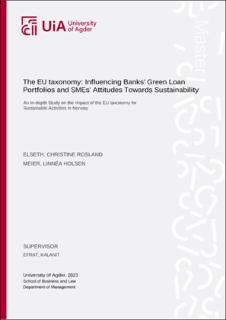| dc.description.abstract | The EU taxonomy was incorporated into Norwegian law at the beginning of 2023, directly impacting listed companies and financial institutions with over 500 employees. It obligates, among other actors, large Norwegian banks to report on their taxonomy-compliant financial activities. Given the EU's strong commitment to achieving climate neutrality by 2025, significant efforts have been made towards sustainable outcomes. It is projected that sustainability reporting aligned with the EU taxonomy will become mandatory for small and medium-sized enterprises (SMEs) by 2025.
This study aims to examine the impact of the EU taxonomy on banks' lending criteria for new commercial buildings and its implications for SMEs in the building and construction sector. The building and construction sector in Norway is responsible for 15 percent of the country's total emissions, with a significant portion of these firms being SMEs. Previous research has highlighted concerns regarding the lack of Norwegian definitions and practical implementation of the EU taxonomy. These studies are related to the impact of the EU taxonomy on actors in the building and construction sector and financial stakeholders. However, a research gap exists regarding the effects of the EU taxonomy on banks' green loan portfolios in relation to SMEs operating in the building and construction sector.
To address this gap, this study seeks to answer the following research questions: "How does the implementation of the EU Taxonomy affect banks' facilitation of a green loan portfolio for new commercial building projects?" and "How do SMEs in the building and construction sector strive to meet the upcoming sustainability requirements imposed by the EU Taxonomy, and what are their attitudes, drivers, and barriers?" We have explored these questions by collecting data through in-depth interviews. Thematic analysis were employed to examine the practical impact of the EU taxonomy on these actors. Our study also facilitates document analysis to gain data on attitudes towards the EU taxonomy in the building and construction sector. The findings indicate that the EU taxonomy serves as the main driver shaping banks' green loan portfolios, while SMEs are indirectly affected by the EU taxonomy through green loans. SMEs exhibits predominantly positive attitudes towards forthcoming sustainability requirements despite some barriers related to resource constraints. | |
